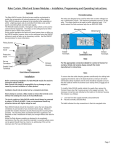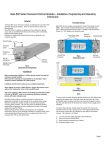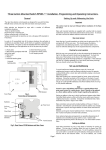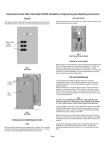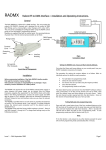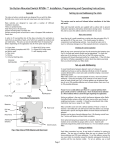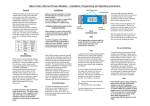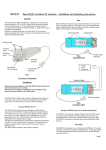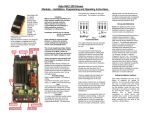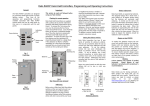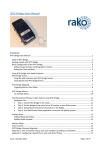Download Rako RDA800 Installation, Programming and Operating Instructions
Transcript
Rako RDA800 Installation, Programming and Operating Instructions General Rako RDA800 modules are dimmer units designed for use with controllable fluorescent ballasts and LED drivers, or any other suitable devices with control inputs for 0-10V, DALI or DSI. RDA800 modules also have an internal relay that switches the mains supply to the fitting. RDA800 modules can be controlled by any Rako device that transmits wireless RAKOM messages. Before commencing installation of a Rako module please read this instruction manual carefully. Rako Controls Ltd accepts no responsibility for damage or injury caused by incorrect installation of a Rako product. Installation should only be carried out by a competent electrician. Never attempt to connect a Rako module or remove the terminal cover without first isolating the circuit at the fuse/MCB board. The circuit supplying a Rako module should always be protected by either a 5A fuse or 6A MCB. Mounting Rako modules should be mounted in areas that are adequately ventilated, dry and outside of any enclosed metal casings that may interfere with the wireless signal. Wherever possible the mounting bracket should be used. Connections Connect the RDA800 module according to the wiring diagram overleaf. Note that the control end of the module has three sets of header pins and one connecting link. The connecting link is used to select the appropriate control output for the load, either 0-10V, DALI or DSI and is set on 0-10V as default. Do not use loop In/Out connections within the module. A junction box should be used if required. Ensure the cable clamp bar securely clamps the cables and that the terminal cover is fitted before switching the supply on. Initial Checks When power is initially connected to the module the unit should switch the load ON. The load can then be manually switched using the clear button on top of the module. The factory set address for both modules and transmitters is House 1 Room 4 (See Fig 1 for further information). A Rako wireless wallpanel set as address House 1 Room 4 will control and dim the module. Should the module not respond as above then further investigation should be made before proceeding further. Modules should be mounted vertically, with the terminals at the bottom, or horizontally with the ventilation slots at the top. To avoid interference between neighbouring installations chose a House address other than the factory default of House 1 and set this on the transmitters using the House address switches. Keep the House address the same throughout the project (for master functions). Chose a Room address for each separate room or area to be controlled independently and set this on the appropriate transmitters using the Room address switches. Note: Any control panels set with the same address will act as two or multi-way controls for the same Room. The module now needs to be sent its new House and Room address from the appropriate keypad. For rooms with multiple modules each module needs to be also assigned a separate Channel number from 1-15 within each Room. The House and Room addresses are set using the switches on the back of a Rako transmitter (see Fig 1) and the Channel addresses are selected by putting a transmitter in programming mode and ‘stepping’ through the channel numbers (see Step 3 overleaf). This number is then 'sent' (along with the House and Room address) to a receiver (Step 5). Notes on address switches The address numbers are set using the switches on the back of a Rako transmitter. Binary coding is used and a diagrammatic explanation is given in Fig 1. It is not however necessary to understand binary just set the House switches to a different setting than the factory default and use a different combination of Room switch settings for each room or area to be controlled separately. Whilst Rako modules are designed to be completely maintenance free the units should be mounted in an accessible location should there be a fault or re-addressing of the unit be necessary (see 'Set-up and Addressing') Loadings Do not exceed the lesser of the two following values: Relay output – Max 800VA Control output – Max 25 devices. Manual Addressing from Wallplate or Handheld Before any lighting scenes can be programmed (see the wall-panel or hand-held manual) the RDA800 module needs to be addressed. Fig.1 Set-Up and Addressing RDA800 modules can be programmed manually or by using RASOFT programming software. For software programming refer to the appropriate programming guide supplied as a PDF with the programming interface (RA or RTC-Bridge etc.) or download from our website: www.rakocontrols.com. Notes on Addressing A dimmer will not receive an address of House 0 (All switches set to off) A dimmer will respond to, but not receive an address of Room 0 (All switches set to off). This Room 0 address is used for ‘Master House’ control A dimmer cannot be set to channel 0. To program a lighting scene see Wall panel or Hand held manual. Power-Up Mode With the factory address setting of House 1 an RDA800 will turn ON when power is applied. When the House address is changed the Power-Up mode becomes 'OFF' which is generally preferred, for instance if there is a power cut during a holiday. Manual Operation The clear button can be used as a manual On/Off switch. Fade Rate An RDA800 module has a default fade rate of zero making its response immediate. It maybe preferable to have a delayed OFF rate when being used in conjunction with dimming modules. The OFF fade rate can be changed by using RASOFT programming software or from a standard wireless 7 or 10 button keypad. To increase the fade rate from a 7 or 10 button wireless keypad Press and Hold both the Off button and the scene 1 button for approximately 5 seconds (the wallpanel LED will start to flash) and then release the buttons. Multiple Control Panels If the module is to be controlled by two wall or handheld transmitters it is only necessary to address the module to one of these transmitters. Set the other transmitters to the same House and Room address and they will transmit exactly the same message as the first transmitter and the module will respond accordingly. LED functions The internal LED behind the clear button will flicker when the module receives ANY Rako wireless message and is a useful diagnostic indicator. This function becomes inactive after 20 minutes to avoid nuisance light spill but can be re-activated by pressing the clear button. If an RDA800 module has already been addressed to a wall-panel the internal LED will start to pulse as soon as that transmitter (or any other transmitter with the same address) is put into programming mode. The module can still be re-addressed in the normal way, for example when changing its Channel address within the same Room. Care and Maintenance A Rako module contains no user serviceable parts. Should for any reason you need to contact us please contact us via our website www.rakocontrols.com or by phoning our customer help line on 01634 226666.


